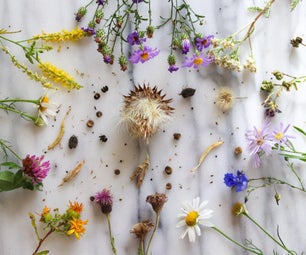Introduction: Eco-Friendly Plant Waterer - Made From Recycled Bottles!
This Is a Simple,Efficient and Green way to Water your Plants.
Why Is It Green?
1. Reduces Plastic Bottles in Landfills
2. You Don't Over Water Your Plants (Saves Water)
3. Uses Natural / Renewable Resources (Rain)
4. Saves You $ Money! $ (By Saving Water)
How It Works:
When soil is wet, it is very dense. As it dries out, it becomes ready to absorb more water.As water in the soil evaporates and is used by the plant, it draws more water out of the supply held in the top reservoir, then into the bottom reservoir and out the holes.
In Simpler Terms:
The Water Replaces the Air Gaps in the Soil.
Therefore the soil Brings in or "Sucks" water from the Bottle.
Bonus!- When it Rains It Fills up the Bottles For You!
NOTE: When I made this Instructable it was Still Winter. So I didn't get to take any pictures of it in the Soil. (Because its Frozen) And any of the Hole Sizes Can Be Changed. Experiment to find the ones that work best!
Step 1: What You Need...
You Will Need...
1. Drill and Drill Bits or Something to cut holes in plastic.
2. Hot Glue, Epoxy or Waterproof Tape
3. Scissors
4. 2 Bottles- One Small and Thin, One Large I.E Liter Bottle (I Didn't Have One)
Step 2: Time to Cut!
Get the Larger of the two Bottles and Your Scissors then Remove the Label as Best You Can.
Next Cut The Bottom Off of the Bottle.
As You Can See...
Step 3: Warm Up Your Drill!
Next Drill a Hole in the top of Both of the Caps.
You can use a Razor Blade or Exacto Knife for this step. BUT BE CAREFUL!!!
Note: For This Step I'm using a 1/2 Drill Bit.
Step 4: Warm Up Your Drill (Con't)
Now Drill Some Holes in the Side of the Smaller Bottle.
The Side That there drilled in is the side that the Plant is Going to Get the Water From.
Remember to Remove The Label!
Note:Hole Sizes can Be Changed. Experiment with different Sizes!
Step 5: Make the Connector
Locate the two caps that you Drilled Holes in Earlier.
Then using Hot Glue, Epoxy or Waterproof Tape. Glue the Two Caps Together.
If your using tape, stretch the tape evenly around the seam of the two caps. Use Multiple Layers.
Step 6: Connect and Your Done!
Just Screw The Two Bottles into Their Proper Caps and Place in Ground!
Fill with Water and Your on Your Way to Saving Money And Time.
Its That Simple!
Bonus!- When it Rains It Fills up the Bottles For You!
Below- Is My Poorly Drawn Picture of it Working.
In Case You Missed it from Before -When I Made this Instructable it was Still Winter. So I didn't get to take any pictures of it in the Soil. (Because its Frozen) And any of the Hole Sizes Can Be Changed. Experiment to find the ones that work best!
Participated in the
Epilog Challenge













